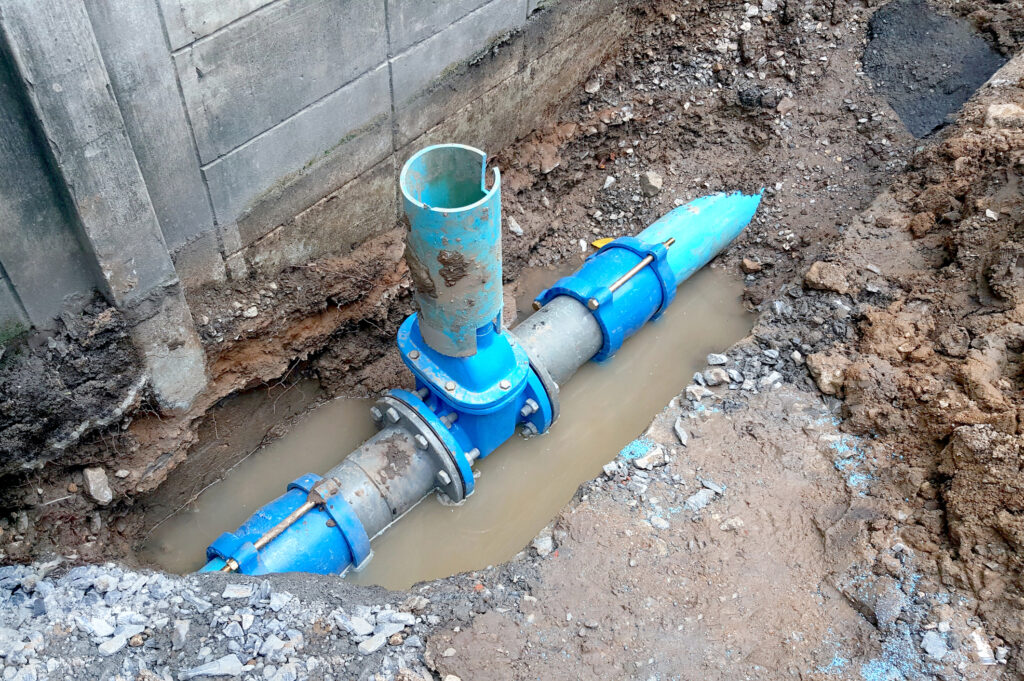Common Drain And Sewer Issues
Causes of Sewer Line Problems
The sewer or drain lines in your home carry the waste water from the bathrooms, kitchen and laundry room out to the street where it is processed by your local water utility company. Whereas the cold water supply lines coming in to your house are pressurized, the sewer lines are not.

Staggs Plumbing has been fixing drainpipe problems in the Plano and Collin County TX areas since 1990 and has vast experience in dealing with your home’s drainage problems. Here are some common causes:
- Mature tree roots. Tree roots can cause havoc with underground pipes, sprinkler lines, cold water supply lines and sewer lines. There is not much you can do to prevent them from happening unless you plant trees far away from any known water lines. In addition, if there is even the tiniest leak in a water pipe, tree roots will seek out the water and accelerate the damage as it makes its way into the pipes in its quest for water.
- Corroded old iron lines. It’s a matter of when iron pipes corrode, not if. Houses built prior to the early 1970’s commonly used cast iron pipes. The life span of a cast iron pipe is typically 25-30 years.
- Foundation movement. The soil in areas around Plano Texas is notorious for shifting due to the high clay content which absorbs water. The movement over time can stress sewer lines running below the house.
- Blockage from household items, toys or other bulky hard objects . Objects can fall into toilets by accident and young children can get quite inquisitive.
Clogged Sewer Pipes
The drains of your house can get clogged for many reasons. Some of them are outside of your control.
Tree Roots
The roots of mature trees can spread wide and far, putting pressure on almost anything that comes across its path. If enough pressure is applied to the pipe material, it can break, leaking fluid around the area.
The tree roots will seek out the water in and around the pipes, eventually growing thick enough to slow down or even stop the flow.
One popular way of fixing this issue is with a plumbing snake with a sharp tool bit on the end. As it rotates through the pipe, it saws through the tree’s roots.
Broken or Corroded Sewer Pipes
A common issue in some of the older houses in the greater Dallas area is a sewer line that has corroded to a point where it cracks and leaks into the soil underneath the foundation of the house. If the sewer lines break underneath the slab, you may notice a slab leak. Please refer to the slab leak page for information on how Staggs Plumbing detects slab leaks.
Iron was frequently used in older homes for the sewer lines, which has a tendency to corrode over time.
This picture shows an example of a sewer pipe that came from one of our client’s houses in Dallas. As you can see, it is severely corroded and has cracks which allowed sewage to escape under the house.
This house was built in the 1960’s, so if your house is quite old, there is a good chance you have iron sewer lines with a potential for corrosion.
Children’s Toys
It’s no joke when you find out that your child’s favorite toy has “gone for a swim” down the toilet and now the toilet runs over whenever it’s flushed. Sometimes toys will get trapped inside the toilet itself (in the bendy pipework) which make it a lot easier to locate and fix.
If it makes its way further downstream, expect a longer and more expensive plumbing task to retrieve or remove the offending object.
How Do I Know if I have a Sewer Pipe Leak?
You may not be aware of a sewer line problem for some time. When it comes time to buy or sell a house, most savvy buyers have a full plumbing system inspection, including the cold water lines and sewer lines to avoid any unexpected surprises down the road. Here are a few signs that you may have an issue with the sewer lines:
- Musky or unnatural odors
- Indentations in the yard which remain soggy over time
- Persistent clogging, slow draining or slow flush is a sign of a sewer issue. We see quite a lot of these issues caused by mature tree roots invading the water lines, it’s not always because of a corroded pipe.
- Damp spots on your floor, possibly along with bad odors.
Fixing a Sewer Line Break
A word of advice – this is not a job for the part-time handyman. Sewers are messy and locating a leak is very difficult to do right.
This issue was addressed by making a hole through the slab in order to access the offending length of pipe.
As noted on the slab leak page, we can sometimes tunnel under the house to access the broken pipes. This takes longer than going through the slab foundation and normally is more expensive due to the length of time involved.
Since we can’t fix a corroded section of pipe, you’ll see here that it was replaced with PVC pipe, which is commonly used in modern home builds.
Locating the Source of a Sewer Leak
This is not a DIY job and is best left to the professionals at Staggs Plumbing.
Basically, we insert small inflatable balls into various sections of the sewer line that provide an airtight seal. Air is then pumped into the lines and tested for any drop in pressure. When air escapes through the pipes, we know the location of the break or breaks in the lines.
Sometimes there are multiple breaks in the line, as was the case in the example described above.
Which Plumber is Qualified?
Many plumbers say they can fix your drainage issue, however, is it worth the risk of saving a few dollars to end up having the problem NOT be fixed.


